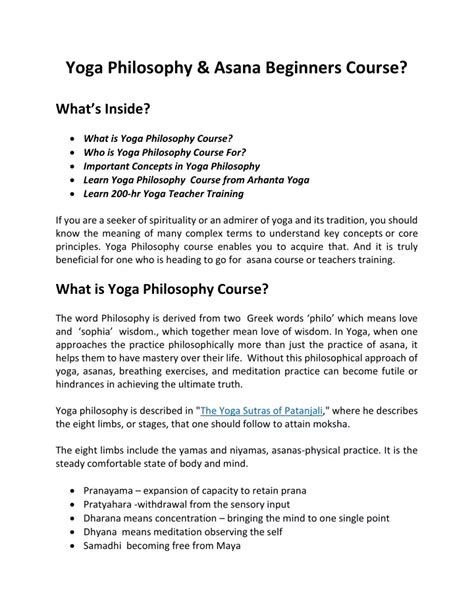Comprehensive Guide to Yoga Philosophy for Beginners: Key Concepts, History, and Practical Applications
Yoga is much more than a physical practice of postures and stretches—it is a rich philosophical system that encompasses ethical guidelines, mental disciplines, and spiritual insights. As a beginner, it can be challenging to understand the depth of yoga’s teachings without guidance. This article aims to explore the fundamental principles of yoga philosophy in a clear and accessible way, touching upon its historical origins, key concepts, current practices, and its future implications. With perspectives from various disciplines, this guide offers a balanced and comprehensive understanding of yoga philosophy.
Introduction
Yoga is often seen as a system of physical exercises or a relaxation technique, but its roots lie in ancient Indian philosophy. Yoga philosophy provides guidelines for living a balanced life, fostering spiritual growth, and understanding the nature of existence. In this guide, we break down the core elements of yoga philosophy, offering practical insights for beginners while maintaining respect for its historical and spiritual depth. We will address common misconceptions, highlight key concepts, and explain how yoga philosophy can be integrated into modern life.
Key Concepts
Yoga philosophy is built upon several core concepts that provide a foundation for understanding the practice in its entirety. These concepts include the following:
- Ashtanga (Eight Limbs of Yoga): A comprehensive system for self-development outlined in Patanjali’s Yoga Sutras. The eight limbs are: Yama (moral discipline), Niyama (personal observances), Asana (posture), Pranayama (breath control), Pratyahara (withdrawal of the senses), Dharana (concentration), Dhyana (meditation), and Samadhi (enlightenment).
- Karma: The law of cause and effect that teaches us that every action has a consequence, shaping our future experiences.
- Dharma: One’s duty or purpose in life, which varies according to personal, social, and spiritual factors.
- Moksha: Liberation from the cycle of birth and rebirth (samsara) through self-realization and enlightenment.
- Purusha and Prakriti: Purusha represents the consciousness or true self, while Prakriti refers to material nature or the physical world.
Historical Context
Yoga philosophy can be traced back over 5,000 years, with its earliest references found in the ancient Indian texts known as the Vedas. The development of yoga philosophy can be divided into several key periods:
| Time Period | Key Developments |
|---|---|
| Vedic Period (1500 BCE – 500 BCE) | The earliest concepts of yoga appear in the Vedas, focusing on rituals and sacrificial practices aimed at spiritual realization. |
| Upanishadic Period (800 BCE – 200 BCE) | The Upanishads introduced philosophical discussions on meditation, self-inquiry, and the nature of the soul. |
| Classical Period (200 BCE – 500 CE) | Patanjali’s Yoga Sutras were written during this time, formalizing the philosophy of Ashtanga yoga. |
| Medieval Period (500 CE – 1500 CE) | Tantric and Hatha yoga texts emerged, emphasizing physical postures, breath control, and energy practices. |
| Modern Period (1890 CE – present) | Yoga spread to the West, evolving into a global practice that integrates physical, mental, and spiritual components. |
Current State Analysis
In modern times, yoga has grown into a multi-faceted practice with varying interpretations and applications. While some view yoga primarily as a physical exercise, others approach it as a spiritual path. The current state of yoga philosophy can be understood through several lenses:
- Physical Yoga: Popularized in the West, this form emphasizes asana (postures) and flexibility. While it offers health benefits, critics argue that it often neglects the deeper philosophical roots of yoga.
- Spiritual Yoga: Rooted in the traditional texts, this practice focuses on meditation, self-inquiry, and spiritual development.
- Holistic Yoga: A balanced approach that integrates the physical, mental, and spiritual dimensions, promoting overall well-being.
Practical Applications
Yoga philosophy offers practical tools for personal growth, mindfulness, and ethical living. Key applications include:
- Mindfulness: By practicing Pratyahara and Dharana, individuals can cultivate awareness of their thoughts, emotions, and actions, leading to greater emotional balance and clarity.
- Stress Reduction: Techniques such as Pranayama (breath control) help reduce stress and promote relaxation.
- Ethical Living: The Yamas and Niyamas provide moral guidelines for treating oneself and others with respect and compassion.
Case Studies
To illustrate the practical benefits of yoga philosophy, consider the following case studies:
| Case Study | Outcome |
|---|---|
| Corporate Mindfulness Programs | Companies that incorporate yoga-based mindfulness programs report reduced employee stress and improved productivity. |
| Yoga in Schools | Schools that teach yoga and mindfulness techniques to students have seen improvements in emotional regulation and focus. |
| Yoga for Veterans | Veterans who practice yoga as part of PTSD recovery report reduced anxiety and improved mental health. |
Stakeholder Analysis
Yoga philosophy influences a diverse group of stakeholders, each with varying interests:
- Practitioners: Individuals seeking personal growth, mental clarity, and physical well-being through yoga.
- Teachers: Instructors who are responsible for transmitting yoga philosophy in a clear and accessible way.
- Medical Community: Researchers and health professionals exploring the benefits of yoga for physical and mental health.
- Religious Groups: Some spiritual communities incorporate yoga into their religious practices.
Implementation Guidelines
For those looking to implement yoga philosophy in their daily lives, here are some guidelines:
- Start Small: Begin with the Yamas and Niyamas to create a foundation of ethical behavior.
- Incorporate Meditation: Set aside a few minutes each day for mindfulness and reflection, practicing Dhyana.
- Practice Asana Regularly: Even a simple yoga practice can help align the body and mind.
- Study the Texts: Read key texts like the Yoga Sutras and the Bhagavad Gita for a deeper understanding.
Ethical Considerations
Yoga philosophy raises important ethical questions, particularly in the areas of cultural appropriation and commercialization:
- Cultural Appropriation: Yoga is deeply rooted in Indian philosophy, and some argue that Western practices often strip it of its cultural and spiritual significance. Practitioners should strive for respectful engagement with yoga’s origins.
- Commercialization: The commodification of yoga, particularly through the marketing of luxury yoga products, raises questions about the true essence of the practice. It’s essential to remember that yoga is a philosophy, not a product.
Limitations and Future Research
While yoga philosophy offers profound insights, it is not without limitations. Some criticisms and areas for further research include:
- Scientific Evidence: While yoga has shown benefits for mental and physical health, more rigorous scientific studies are needed to understand its long-term effects fully.
- Inclusivity: Yoga is often seen as inaccessible to certain populations due to its commercialization and association with particular body types. Future research should explore ways to make yoga more inclusive and diverse.
- Integration with Modern Science: Yoga’s teachings on consciousness and the mind could be further integrated with modern neuroscience and psychology.
Expert Commentary
Yoga philosophy remains a dynamic and evolving field, with new perspectives and interpretations constantly emerging. Experts from various backgrounds agree on its potential to promote mental well-being, ethical living, and spiritual growth, yet they also call for ongoing reflection on how it is practiced and transmitted globally. As yoga continues to expand, it’s important to stay grounded in its philosophical roots while adapting to contemporary challenges and opportunities.








